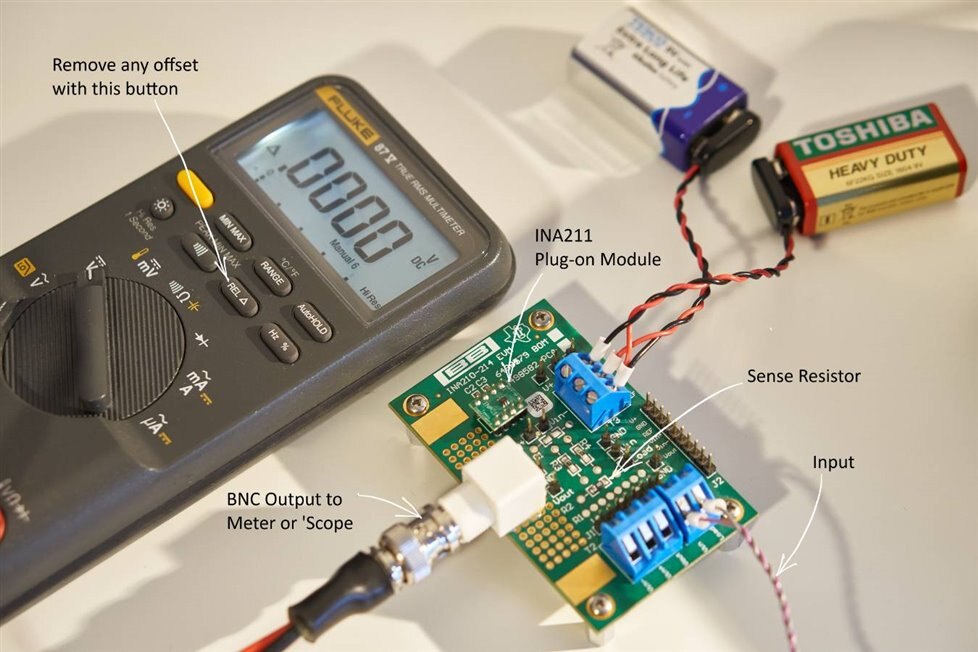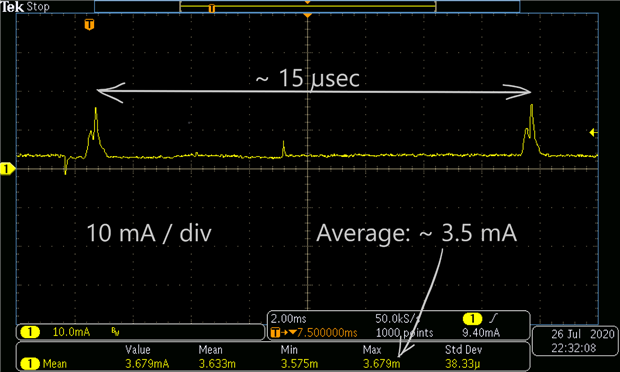Introduction
This short blog post documents a simple project to measure current in devices that may have low power operation for periods, but possibly have periods of high current draw.
I recently needed to monitor the current of a few wireless devices, and I wanted a way to measure up to an amp or so, but to also be able to resolve tens of microamps in the same range. This is a simple project that can be constructed in half an hour, so there’s not a lot of text to read!
Working with the INA210 Evaluation Kit
Texas Instruments offers an evaluation kit for the INA2xx series of Current Sense Amplifiers. These are great because they contain an all-in-one solution. All that is really needed is a sense resistor. In normal use the sense resistor will be in-line with the positive supply wire of the equipment under test. The kit contains several INA2xx devices, each with a different hard-wired gain setting. Unfortunately the kit is no longer sold, but there is an alternative INA210-215EVM kit which can be used for a similar purpose (better in some ways, because it has more PCBs).
The sense resistor value is always a compromise, since too high a value will exhibit a higher voltage drop, and too low a value won't allow for the lowest-noise measurements at lower currents. I purchased a 20 milliohm 1210 sized resistor and soldered it on, the thinking being that I could scale to different current ranges by swapping out the plug-on INA2xx modules. However, I see myself using the INA211 INA211 for most of the time, because it offers a gain of 500. This means that when 1A of current is flowing, the 20 milliohm resistor will have 20 millivolts across it, and the gain of 500 will result in an output of 10 volts. In other words, the output will be 10 mV per milliamp. The INA211 has a bandwidth of 7 kHz, but it could be swapped with INA214 INA214 for 30 kHz bandwidth and gain of 100 if desired.
A 9 volt battery will allow measurement up to 900 milliamps or thereabouts, and that seemed good enough for my purposes.
There’s a small issue with the INA2xx series, in that there is an offset at very low output voltages, and therefore very small currents cannot be measured without a negative rail. The easiest fix was to use two 9 volt batteries, and push off the problem to the very negative end of the scale. This means that the solution can now monitor currents flowing in either direction, from almost -900 mA to +900 mA (I measured up to 800 mA in both directions with a power supply to briefly verify operation at these higher current values).
There’s a 1-minute video about the project here:
Example Output
Here’s the current consumption for a BGX13P BLE chip, during its connected phase. It was possible to determine that the average current is around 3.6 mA. This closely matched with the datasheet typical value of 3.5 mA.
This isn’t a super-exhaustive test, but the end device was for a purpose, and I needed to continue with it rather than test the INA board extensively! Still, it shows that the measurements are clean enough for a few tens of microamps of current to be monitored, and as mentioned it can function to beyond 800 mA in both directions. Playing with the gain and resistors would of course allow for different ranges of interest.
Next Steps
It could be possible to produce a PCB for this project, with two or four INA2xx parts on it, the reason being, multiple channels could be handy for measuring different parts of a circuit simultaneously. Each channel could be preset to a different max current limit, so if you’re (say) measuring the low-power sensor part of a project on one channel, then you could select the channel with the highest sensitivity for that.
Also, it's good to sometimes explore other current measurement methods to use the right tool for the right job. For instance, for isolated, or higher current DC measurements, the Pico Technology TA018Pico Technology TA018 is very nice too, and a reasonable price. It too comes with a BNC plug on the end, ready for 'scoping.
Thanks for reading!



Top Comments
-

neilk
-
Cancel
-
Vote Up
+4
Vote Down
-
-
Sign in to reply
-
More
-
Cancel
Comment-

neilk
-
Cancel
-
Vote Up
+4
Vote Down
-
-
Sign in to reply
-
More
-
Cancel
Children